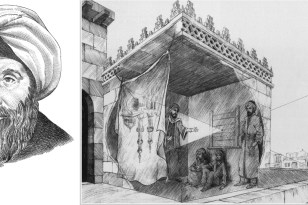Optics

July 4, 2017
Optics
Published: 2002
In the Genius Arab Civilization, A. I Sabra stated, “Ibn al Haytham’s most important contributions were in the fields of Optics, Mathematics, and Astronomy. His most important single work is the comprehensive Kitab al-Manazir (The Book of Optics).
Ibn Al-Haitham
Until the revival of optics in Persia, towards the end of the 13th century, Ibn Al-Haythm was mainly known to the Islamic world as a mathematician and as an astronomer. Still, his best-known and most influential work in Europe was the Optics. It was largely on this basis of his book that George Satorn described Ibn Al-Haytham as “the greatest Muslim physicist and one of the greatest students of optics of all times.”
Other optical subjects of Ibn Al-Haytham include: “On the light of the Moon, that argues that the moon shines like a self-luminous object, though its light is borrowed from the Sun; On the Halo and Rainbow; On Spherical Burning Mirrors; On Paraboloidal Burning Mirrors; and On the Shape of Eclipse, which examines the camera Obscura phenomena.
The Invention of the Camera Camera Obscura Model Ibn-al Haytham and his student Kamal ad-Din teamed up making history when they first observed and recorded the Obscura phenomenon. The Obscura phenomenon is literary defined by Webster’s dictionary as “dark chamber.” Usually is cardboard with a tiny pinhole that began the groundwork of a camera.
What is Taught: Isaac Newton’s 17th-century study of lenses, light, and prisms forms the foundation of the modern science of optics.
What Should be Taught: In the 11th century, al-Haytham determined virtually everything Newton advanced regarding optics centuries prior and regarded by numerous authorities as to the “founder of optics.”
There is little doubt that he influenced Newton. Al-Haytham was the most quoted physicist of the Middle Ages. His works were utilized and quoted by many European scholars during the 16th and 17th centuries than those of Newton and Galileo combined.
Al-Haytham’s Math work
What is Taught: Isaac Newton, during the 17th century, discovered that white light consists of various rays of colored light.
What Should be Taught: This discovery was made in its entirety by al-Haytham (11th century) and Kamal ad-Din (14th century). Newton did make original discoveries, but this was not one of them.
What is Taught: The English scholar Roger Bacon (d. 1292) first mentioned glass lenses for improving vision. At nearly the same time, eyeglasses could be found in use in both China and Europe.
What Should be Taught: Ibn Firnas of Islamic Spain invented eyeglasses during the 9th century, and they were manufactured and sold throughout Spain for over two centuries.
Any mention of eyeglasses by Roger Bacon was simply a regurgitation of the work of al-Haytham (d. 1039), whose research Bacon frequently referenced.
Recommended Posts

Women’s Rights to Own Property
January 20, 2018

Navigation
January 20, 2018

Algebra
July 4, 2017

